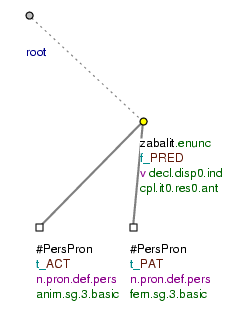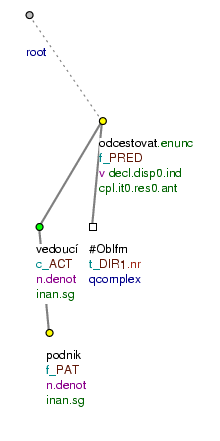Ellipsis of the dependent element is such a case of ellipsis in which a dependent modification is missing from the surface form of the sentence, which is, however, present in the meaning of the sentence. For the most part, we only represent ellipsis of obligatory valency modifications (see Section 12.2.1, "Ellipsis of an obligatory modification"). Ellipsis of optional modifications is represented only in exceptional cases (see Section 12.2.2, "Ellipsis of a non-obligatory modification").
The present section describes the general cases of ellipsis of the dependent element, in which the omitted modification cannot be represented as a shared modifier (of paratactically connected elements). Ellipsis in paratactic structures is described separately in Section 12.3, "Ellipsis and the principle of shared modification in paratactic structures".
Ellipsis of an obligatory modification is such a case of ellipsis in which an obligatory valency modification is not present in the surface form of the sentence.
Nodes representing words with valency (verbs, nouns, adjectives and adverbs, see Section 2, "Valency"), including copied nodes (see Section 12.1, "Ellipsis of the governing element"), are assigned a valency frame: the obligatory modifications of the given word (i.e. those included in its valency frame) are, then, always represented by a node in the tectogrammatical tree. Non-expressed obligatory modifications are represented by newly established nodes with appropriate t-lemma substitutes.
For details see Section 2.4, "Representing valency in the tectogrammatical trees".
!!! For details on valency as represented in PDT see Section 2.4, "Representing valency in the tectogrammatical trees".
The annotation distinguishes different instances of ellipsis of an obligatory modification by different t-lemma substitutes. Also in this case, textual and grammatical ellipsis are represented in a different way.
Ellipsis of an obligatory modification is not represented in the following cases:
-
the governing node has a t-lemma substitute.
If, for example, a node with the t-lemma
#PersPronstands in a place of a verb (the coreferred element is the governing verb of a clause, for example), no nodes for the (non-expressed) valency modifications of the substituted verb are inserted under this node.The same holds for nodes with the t-lemma substitutes
#EmpVerbor#EmpNoun.Exception: A node representing an empty verb (node with t-lemma
#EmpVerb) can only get a new dependent node (representing an expression unexpressed in the surface structure of the sentence) in order to capture possible grammatical coreferential relations (see Section 2, "Grammatical coreference"), or in order to indicate the second dependency of a possible complement (see Section 10, "Predicative complement (dual dependency)").
Optional modifications. If an optional modification is not expressed in the surface form of the sentence, we take its absence to be a result of its optionality and thus do not represent the ellipsis. Non-expressed optional modifications are not assigned a node in the tectogrammatical tree (for more on this see Section 2.4.1, "General arguments and unspecified Actors").
Exception: A new node for an optional modification (non-expressed in the surface structure of the sentence) is only added into the tectogrammatical tree if it is necessary for representing grammatical coreference relations properly (see Section 2, "Grammatical coreference"), or for representing the second dependency with predicative complements (see Section 10, "Predicative complement (dual dependency)"). The omitted optional modification can also be represented as a shared modifier in paratactic structures (see Section 12.3.1, "Textual ellipsis of a non-obligatory modification in paratactic structures").
12.2.1.1. Textual ellipsis of an obligatory argument (the t-lemma substitutes #PersPron, #Cor, #QCor a #Rcp)
Textual ellipsis of an obligatory argument comprises such cases in which the coreferred element of the omitted modification can be straightforwardly identified with the help of the preceding or following context.
The t-lemma of the newly established node (for the omitted valency modifications) reflects the type of coreference (textual and grammatical coreference; see Chapter 9, Coreference) and also signals the particular type of elision:
-
textual ellipsis of an argument not entering into grammatical coreference relations.
A newly established node for an argument, subject to textual ellipsis, is assigned the t-lemma
#PersPron. If this node does not represent a 1st or 2nd person pronoun, its textual coreference is indicated. See Section 3, "Textual coreference".A node with the t-lemma substitute
#PersPronis also used for representing the non-expressed (null) subject (of the governing verb) of the clause - if it is not a case of the unspecified Actor (t_lemma=#Unsp; viz Section 2.4.1, "General arguments and unspecified Actors").What is typical for this type of ellipsis is that it is possible to express the omitted modifications, e.g. by the pronoun on or ten.
Cf.:
-
(Firma měla doručit zboží zákazníkovi.) Doručení {
#PersPron.ACT} {#PersPron.PAT} {#PersPron.ADDR} se však neuskutečnilo. (=lit. (The_company was_to deliver the_goods to_the_customer.) The_delivery {#PersPron} {#PersPron} REFL however did_not_happen.)It is clear from the context, that all the obligatory arguments of the noun doručení (=delivery) are instances of textual ellipses (Actor = firma (=company), Patient = zboží (=goods), Addressee = zákazník (=customer)). For each of these position, a newly established node with t-lemma substitute
#PersPronand appropriate functor will be inserted into the tectogrammatical tree. -
{
#PersPron.ACT} Jsi zlý. (=lit. (You) are mean.)A newly established node with with t-lemma substitute
#PersPronand appropriate functor is inserted into the tectogrammatical tree in the position of the non-expressed subject. -
{
#PersPron.PAT} Byl pochválen. (=lit. (He) was praised.)A newly established node with with t-lemma substitute
#PersPronand appropriate functor is inserted into the tectogrammatical tree in the position of the non-expressed (null) subject.
More examples:
(Zabalil prodavač už tu knihu?) Zabalil {
#PersPron.ACT} {#PersPron.PAT} (=lit. (Did_pack the_shop_assistant already the book?) (He) packed.) Fig. 6.213(Vedoucí tu dnes není.) Odjel na konferenci {
#PersPron.ACT} (=lit. (The_boss here today is_not.) (He) left for a_conference.)NB! A node with the t-lemma substitute
#PersPronis used in cases of textual ellipsis (i.e. where there is no grammatical coreference) no matter what the form of the omitted argument is; i.e. not only in the positions where it could be replaced by a personal or possesive pronoun.NB! The t-lemma
#PersPronis a t-lemma substitute used also for representing all expressed personal and possesive pronouns (see Section 2, "The relation between a node's t-lemma and m-lemma and between its t-lemma and word form").!!! In the future, it will be necessary to reserve the t-lemma
#PersPronfor representing expressed as well as non-expressed personal and possesive pronouns and to introduce a new t-lemma for other types of omitted obligatory arguments. -
-
textual ellipsis of an argument entering into a control relation.
The newly established node for the omitted argument participating in a control relation is assigned the t-lemma
#Cor.Example:
Kolega má zájem {
#Cor.ACT} učit se španělsky. (=lit. Colleague has interest {#Cor} to_learn REFL Spanish.)For more on control see Section 2.4, "Control".
-
textual ellipsis of an argument entering into a quasi-control relation.
The newly established node for the omitted argument participating in a quasi-control relation is assigned the t-lemma
#QCor.Example:
Kolega má {
#QCor.ACT} zájem učit se španělsky. (=lit. Colleague has {#QCor} interest to_learn REFL Spanish.)For more on quasi-control see Section 2.5, "Quasi-control" and Section 9.3.4.2, "Sharing of valency modifications between the verbal and nominal components (quasi-control)".
-
textual ellipsis of an argument entering into a reciprocal relation.
The newly established node for the omitted argument participating in a reciprocal relation is assigned the t-lemma
#Rcp.Example:
Otec a matka se každý večer hádají {
#Rcp.ADDR} . (=lit. Father and mother REFL every evening have_fight {#Rcp}.)For more on reciprocity see Section 2.6, "Coreference in constructions with reciprocity" and Section 2.4.2, "Reciprocity".
Grammatical ellipsis of an obligatory argument comprises such cases in which the coreferred element of the omitted modification cannot be clearly identified (with the help of the context).
This concerns especially the following two types:
-
general argument.
The newly established node for the general argument has the t-lemma
#Gen.Example:
Do této buchty se dává sůl {
#Gen.ACT} (=lit. Into this cake REFL gives salt {#Gen}.) -
unspecified Actor.
The newly established node for the unspecified Actor has the t-lemma
#Unsp.Example:
Psali to v novinách {
#Unsp.ACT} (=lit. (They) wrote it in the_newspapers {#Unsp}.)
For more on the general argument and unspecified Actor see Section 2.4.1, "General arguments and unspecified Actors".
With omitted obligatory free modifications, we distinguish grammatical and textual ellipsis only partially.
We distinguish the following two types (by using two different t-lemmas):
-
ellipsis of an obligatory free modification participating in a reciprocal relation.
The newly established node for the omitted obligatory free modification participating in a reciprocal relation is assigned the t-lemma
#Rcp.Example:
Poslanci přehazují návrh zákona mezi klubem a sněmovnou {
#Rcp.DIR3} (=lit. The_MPs toss proposal of_law between the_club and the_parliament {#Rcp}.)For more on reciprocity see Section 2.6, "Coreference in constructions with reciprocity" and Section 2.4.2, "Reciprocity".
-
other cases of ellipsis of obligatory free modifications.
The newly established node for the omitted obligatory free modification, not participating in a reciprocal relation, is assigned the t-lemma
#Oblfm.Examples:
Vedoucí podniku odcestoval{
#Oblfm.DIR1} (=lit. The_boss of_the_company left {#Oblfm}.) Fig. 6.214Ten vypadá! {
#Oblfm.MANN} (=lit. He looks! {#Oblfm}.)
NB! The possibility to assign the t-lemma substitute #Oblfm can be in some cases limited by other annotation rules. The node representing a non-expressed obligatory free modification in constructions with the meaning of comparison (see Section 4, "Constructions with the meaning of "comparison""), restriction (see Section 6.1, "Meaning of "restriction"") and in constructions with consecutive clauses (see Section 7, "Constructions with a dependent consecutive clause") can be assigned the t-lemma #Equal, #Total or #AsMuch. The t-lemmas #Equal, #Total or #AsMuch are to be preferred over the #Oblfm t-lemma.
!!!So far the annotation has made no difference between the cases of non-expressed obligatory free modifications in which the absence of the modification is a result of textual ellipsis and those in which there are different reasons for the omission (the coreference relations have not been indicated with these modifications so far). In addition, it is becoming obvious that the possibility to omit an obligatory free modification is not always a result of textual ellipsis or a process of the modification becoming general (which may be happen with arguments). The possibilty to simply omit the modification in the surface structure of the sentence should be taken into account too.
Ellipsis of a non-obligatory modification is not represented in any way in most cases. However, there are two special cases in which it is necessary to insert a node representing the non-expressed free modification into the tectogrammatical tree:
-
constructions with a control relation.
In constructions with control, new nodes for the
BENmodifications are sometimes inserted into the tectogrammatical tree - in order to represent the grammatical coreference relations properly. These nodes get the t-lemma substitute#Benef.For more on these constructions see Section 2.4, "Control".
-
paratactic structures.
Ellipsis of non-obligatory modifications (free modifications and optional arguments) in paratactic structures is discussed in Section 12.3, "Ellipsis and the principle of shared modification in paratactic structures".

